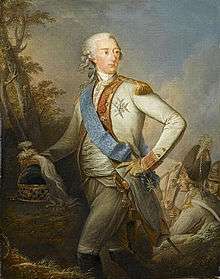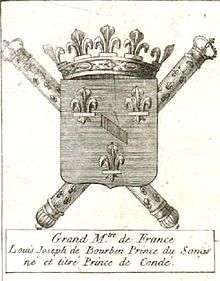Louis Joseph, Prince of Condé
| Louis Joseph | |||||
|---|---|---|---|---|---|
 | |||||
| Prince of Condé | |||||
| Reign | 27 January 1740 – 13 May 1818 | ||||
| Predecessor | Louis Henri | ||||
| Successor | Louis Henri | ||||
| Born |
9 August 1736 Hôtel de Condé, Paris, France | ||||
| Died |
13 May 1818 (aged 81) Palais Bourbon, Paris, France | ||||
| Burial | Basilica of Saint Denis | ||||
| Spouse | |||||
| Issue Detail | |||||
| |||||
| House | Condé | ||||
| Father | Louis Henri, Duke of Bourbon | ||||
| Mother | Caroline of Hesse-Rotenburg | ||||
| Religion | Roman Catholicism | ||||
| Signature |
| ||||

Louis Joseph de Bourbon (9 August 1736 – 13 May 1818) was Prince of Condé from 1740 to his death. A member of the House of Bourbon, he held the prestigious rank of Prince du Sang.
Youth
Born on 9 August 1736 at Chantilly,[1] Louis Joseph was the only son of Louis Henri de Bourbon, Duke of Bourbon (1692–1740) and Landgravine Caroline of Hesse-Rotenburg (1714–41). As a cadet of the reigning House of Bourbon, he was a prince du sang. His father Louis Henri, was the eldest son of Louis de Bourbon, Prince of Condé (known as Monsieur le Duc) and his wife Louise Françoise de Bourbon, legitimated daughter of Louis XIV and Madame de Montespan.
During his father's lifetime, the infant Louis Joseph was known as the Duke of Enghien, (duc d'Enghien). At the age of four, following his father's death in 1740, and his mother's death in 1741,[1] he was placed under the care of his paternal uncle, Louis, Count of Clermont, his father's youngest brother.
Family
He had an older half sister, Henriette de Bourbon, Mademoiselle de Verneuil (1725–1780).
Through his mother, he was a first cousin of Victor Amadeus III of Sardinia and of the princesse de Lamballe. His paternal cousins included the Louise Henriette de Bourbon, Duchess of Orléans (mother of Philippe Égalité) and sister of Louis François, prince de Conti, head of another cadet branch of the royal dynasty. Viktoria of Hesse-Rotenburg, the Princess of Soubise was another first cousin.
He married Charlotte de Rohan (1737–1760) in 1753, the daughter of King Louis XV's friend, the Charles, prince de Soubise. Charlotte's mother, Anne Marie Louise de La Tour d'Auvergne, was a daughter of the reigning Duke of Bouillon. The couple were married at Versailles on 3 May 1753.
Together, they had three children: a daughter, Marie, who died young; Louis Henri Joseph, who would become the last prince de Condé; and a daughter, Louise Adélaïde. In 1764, he renovated and expand the Palais Bourbon, and to leave the Hôtel de Condé[2] where he was born. The latter residence was bought by Louis XV in 1770, subsequent site of the Odéon Theatre.
In 1770, his son married Bathilde d'Orléans, daughter of Louis Philippe, Duke of Orléans and sister of Philippe Égalité. The marriage was supposed to heal relations between the Condé and Orléans branches of the royal family.[3]
Condé's first wife died in 1760, and as time passed his relationship with Maria Caterina Brignole, Princess of Monaco, became serious. By 1769 she had begun to set up a home in the Hôtel de Lassay, an annex of the prince de Condé's primary residence, the Palais-Bourbon.[4] In 1770 her jealous husband, the reigning Prince, ordered the borders of Monaco closed in an attempt to prevent her from escaping. She managed, nonetheless, to cross into France and found her way to Le Mans, southwest of Paris, where she took refuge in a convent. Eventually she was able to return to Paris.
Due to Maria Caterina's illicit position as Condé's mistress, the new French queen, 18-year-old Marie Antoinette treated her poorly at court, which offended Condé. In about 1774 Condé and Maria Caterina began the construction of the Hôtel de Monaco, to be her permanent home in Paris. It was in the rue Saint-Dominique, near the Palais Bourbon, and was completed in 1777.[4] Prince Honoré finally realized his relationship with Maria Caterina was completely finished and turned his attention to his own love affairs. Maria Caterina wrote to her husband that their marriage could be summarised in three words: greed, bravery, and jealousy.
Later life
Maria lived with Condé in France until the French revolution, when the couple left for Germany and then Great Britain. In 1795 Prince Honoré died, and on 24 October 1798 she and the prince de Condé were married in London.[5][6] The marriage was kept secret for a decade, the couple reportedly only becoming openly known as husband and wife as of 26 December 1808.[5]
The prince was the leader of the Condé army of émigrés. She used her great fortune to help finance the exiled French community's resistance movement.
Among other estates, Louis Joseph inherited the famous Château de Chantilly, the main seat of the Condé line. At Chantilly, the prince conducted a number of improvements and embellishments in the years before the French Revolution. He had the Château d'Enghien built on the grounds of the estate to house guests when the prince entertained at Chantilly. It was constructed in 1769 by the architect Jean François Leroy and was later renamed the Château d'Enghien in honour of his grandson Louis Antoine, Duke of Enghien[7] who was born at Chantilly in 1772. He also commissioned a large garden in the English style as well as an hameau, much like the contemporary Marie Antoinette had created at Versailles and the Petit Trianon.
In 1765, named the heir of his paternal aunt Élisabeth Alexandrine de Bourbon, he received generous pensions which Élisabeth Alexandrine had in turn acquired from her cousin, Mademoiselle du Maine.
During both the reigns of Louis XV and Louis XVI, the prince held the position of Grand Maître de France in the king's royal household, the Maison du Roi.
Obtaining the rank of general, Condé fought in the Seven Years' War with some distinction, serving alongside his father in law, the prince de Soubise. He was also Governor of Burgundy.
Exile
After the storming of the Bastille in 1789, Louis Joseph fled France with his son and grandson, before the Reign of Terror which arrested, tried and guillotined most of the Bourbons still living in France: Louis XVI, Marie Antoinette and the Duke of Orleans (Philippe Égalité) were executed in 1793, and the king's sister, Madame Élisabeth, was beheaded in 1794.
During the French Revolution, the prince was a dedicated supporter of the monarchy and one of the principal leaders of the counter-revolutionary movement. He established himself at Coblenz in 1791, where he helped to organize and lead a large counter-revolutionary army of émigrés. In addition to containing the prince's grandson, Louis-Antoine-Henri de Bourbon-Condé, duc d'Enghien, and the two sons of his cousin, the late king's brother, the comte d'Artois, the corps included many young aristocrats who eventually became leaders during the Bourbon Restoration years later.
This group included Armand-Emmanuel du Plessis, Duc de Richelieu, Pierre Louis Jean Casimir de Blacas and François-René de Chateaubriand.
The Army of Condé initially fought in conjunction with the Austrians. Later, due to differences with the Austrian plan of attack, however, the Prince de Condé entered with his corps into English pay in 1795. In 1796, the army fought in Swabia. In 1797, Austria signed the Treaty of Campo Formio with the First French Republic, formally ending its hostilities against the French. With the loss of its closest allies, the army transferred into the service of the Russian tsar, Paul I and was stationed in Poland, returning in 1799 to the Rhine under Alexander Suvorov. In 1800 when Russia left the Allied coalition, the army re-entered English service and fought in Bavaria.
The army was disbanded in 1801 without having achieved its principal ambition, restoring Bourbon rule in France. After the dissolution of the corps, the prince spent his exile in England, where he lived with his second wife, Maria Caterina Brignole, the divorced wife of Honoré III, Prince of Monaco, whom he had married in 1798. She died in 1813.
With the defeat of Napoleon, Louis Joseph returned to Paris, where he resumed his courtly duties as grand maître in the royal household of Louis XVIII. He died in 1818 and was succeeded by his son, Louis Henri. His daughter, Louise Adélaïde de Bourbon, who was a nun and had become the abbess of Remiremont Abbey, survived until 1824. He was buried at the Basilica of St Denis.
Issue
- Marie de Bourbon, Mademoiselle de Bourbon (16 February 1755 - 22 June 1759) died in infancy.
- Louis Henri Joseph de Bourbon, Prince of Condé, Duke of Bourbon (13 April 1756 - 30 August 1830) married Bathilde d'Orléans and had issue.
- Louise Adélaïde de Bourbon (5 October 1757 - 10 March 1824) died unmarried.
Ancestry
| Ancestors of Louis Joseph, Prince of Condé | ||||||||||||||||||||||||||||||||||||||||||||||||||||||||||||||||||||||||||||||||||||||||||||||||||||||||||||||||||||||||||||||||||||||||||||||||||||||||||||||||||||||||||||||||||||||||||||||||||||||||||||||||||||||||||||||||||||||||||||||||||||||||||||||||||||||||||||||||||||||||||||||||||||||||||||||||||||||||||||||||||||||||||||||||||||||||||||||||||||||||||||||||||||||||||||||||||||||||||||||||||||||||||||||||||||||||||||||||||||||||||||||||||||||||||||||||||||||||||||||||||||||||||||||||||||||||||||||||||
|---|---|---|---|---|---|---|---|---|---|---|---|---|---|---|---|---|---|---|---|---|---|---|---|---|---|---|---|---|---|---|---|---|---|---|---|---|---|---|---|---|---|---|---|---|---|---|---|---|---|---|---|---|---|---|---|---|---|---|---|---|---|---|---|---|---|---|---|---|---|---|---|---|---|---|---|---|---|---|---|---|---|---|---|---|---|---|---|---|---|---|---|---|---|---|---|---|---|---|---|---|---|---|---|---|---|---|---|---|---|---|---|---|---|---|---|---|---|---|---|---|---|---|---|---|---|---|---|---|---|---|---|---|---|---|---|---|---|---|---|---|---|---|---|---|---|---|---|---|---|---|---|---|---|---|---|---|---|---|---|---|---|---|---|---|---|---|---|---|---|---|---|---|---|---|---|---|---|---|---|---|---|---|---|---|---|---|---|---|---|---|---|---|---|---|---|---|---|---|---|---|---|---|---|---|---|---|---|---|---|---|---|---|---|---|---|---|---|---|---|---|---|---|---|---|---|---|---|---|---|---|---|---|---|---|---|---|---|---|---|---|---|---|---|---|---|---|---|---|---|---|---|---|---|---|---|---|---|---|---|---|---|---|---|---|---|---|---|---|---|---|---|---|---|---|---|---|---|---|---|---|---|---|---|---|---|---|---|---|---|---|---|---|---|---|---|---|---|---|---|---|---|---|---|---|---|---|---|---|---|---|---|---|---|---|---|---|---|---|---|---|---|---|---|---|---|---|---|---|---|---|---|---|---|---|---|---|---|---|---|---|---|---|---|---|---|---|---|---|---|---|---|---|---|---|---|---|---|---|---|---|---|---|---|---|---|---|---|---|---|---|---|---|---|---|---|---|---|---|---|---|---|---|---|---|---|---|---|---|---|---|---|---|---|---|---|---|---|---|---|---|---|---|---|---|---|---|---|---|---|---|---|---|---|---|---|---|---|---|---|---|---|---|---|---|---|---|---|---|---|---|---|---|---|---|---|---|---|---|---|---|---|---|---|---|---|---|---|---|---|---|---|---|---|---|---|---|---|---|---|---|---|---|---|---|---|---|---|---|---|---|---|---|---|---|---|---|---|---|---|---|---|---|---|---|---|---|---|---|---|---|---|---|---|---|---|---|---|---|---|---|---|---|---|---|---|---|---|---|---|---|---|---|---|---|
| ||||||||||||||||||||||||||||||||||||||||||||||||||||||||||||||||||||||||||||||||||||||||||||||||||||||||||||||||||||||||||||||||||||||||||||||||||||||||||||||||||||||||||||||||||||||||||||||||||||||||||||||||||||||||||||||||||||||||||||||||||||||||||||||||||||||||||||||||||||||||||||||||||||||||||||||||||||||||||||||||||||||||||||||||||||||||||||||||||||||||||||||||||||||||||||||||||||||||||||||||||||||||||||||||||||||||||||||||||||||||||||||||||||||||||||||||||||||||||||||||||||||||||||||||||||||||||||||||||
Titles, styles, honours and arms

Titles and styles
- 9 August 1736 – 27 January 1740 His Serene Highness the Duke of Enghien
- 27 January 1740 – 13 May 1818 His Serene Highness the Prince of Condé
References and notes
- 1 2 "BIOGRAPHICAL ETCHING.". The Sydney Gazette and New South Wales Advertiser. 15 January 1820. Retrieved 15 November 2013.
- ↑ It was at the Hôtel de Condé that the Marquis de Sade was born, his mother was a lady-in-waiting to Louis Joseph's mother, Caroline
- ↑ Louis Joseph's grandmother, Mademoiselle de Nantes was the older sister of Louis Philippe's grandmother Mademoiselle de Blois, legitimated daughters of Louis XIV
- 1 2 Braham (1980), p. 215.
- 1 2 Montgomery-Massingberd, Hugh (1980). "Addendum: Burke's Royal Families of the World Volume I: Europe & Latin America". Burke’s Royal Families of the World: Volume II Africa & the Middle East. p. 315. ISBN 0-85011-029-7.
- ↑ The Royalty, peerage and aristocracy of the world, Vol 90
- ↑ The famous victim of Napoleon I of France
Succession
| Louis Joseph, Prince of Condé Cadet branch of the House of Bourbon Born: 9 August 1736 Died: 13 May 1818 | ||
| French nobility | ||
|---|---|---|
| Preceded by Louis Henri de Bourbon |
Prince of Condé 27 January 1740 – 13 May 1818 |
Succeeded by Louis Henri de Bourbon |
See also
External links
![]() Media related to Louis Joseph, Prince of Condé at Wikimedia Commons
Media related to Louis Joseph, Prince of Condé at Wikimedia Commons